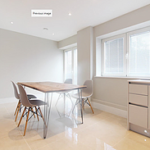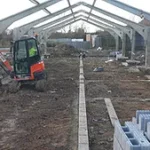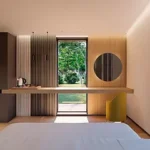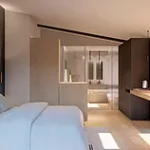New Creo Research & Test House in the UK
A new Hydrogen Test & Research house will be built in South Wales using Creo`s proprietary Creo-block construction to create a well-insulated and zero-carbon house with industry best U-values of 0.14 ( Passive Haus standards 0.15 ). Other than Creo`s original research house, this will be the first new house to be built in the UK using Creo`s green hydrogen production system enabling the house to be totally off-Grid and which will be controlled by Creo`s protected and unique AI System.
Using solar power and Tesla batteries to provide most of the house`s electricity needs, together with its low energy requirements, the shortfall in electricity over the winter months will be provided by the green hydrogen produced by the Creo Hydrogen Stack on site. This will provide all of the house`s energy needs enabling the house to be off-Grid if required and totally self-sufficient in terms of energy.
The Green-Hydrogen produced will be stored on site in the Creo Hydrogen Storage Tank until required to create electricity through the fuel cell, which is then transferred to the house. The house will be completed mid-2023 and will be available for viewing to showcase the unique AI controlled Hydrogen system working and how a Zero-carbon house can be built.
Western House, Llanelli, South Wales

Kitchen showing a 100% Hydrogen Boiler ( if available in the market in time )

Rear garden showing the Creo Hydrogen Production Facility and Creo Hydrogen Storage Tank
New Creo Research & Test House in the UK
A new Hydrogen Test & Research house will be built in South Wales using Creo`s proprietary Creo-block construction to create a well-insulated and zero-carbon house with industry best U-values of 0.14 ( Passive Haus standards 0.15 ). Other than Creo`s original research house, this will be the first new house to be built in the UK using Creo`s green hydrogen production system enabling the house to be totally off-Grid and which will be controlled by Creo`s protected and unique AI System.
Using solar power and Tesla batteries to provide most of the house`s electricity needs, together with its low energy requirements, the shortfall in electricity over the winter months will be provided by the green hydrogen produced by the Creo Hydrogen Stack on site. This will provide all of the house`s energy needs enabling the house to be off-Grid if required and totally self-sufficient in terms of energy.
The Green-Hydrogen produced will be stored on site in the Creo Hydrogen Storage Tank until required to create electricity through the fuel cell, which is then transferred to the house. The house will be completed mid-2023 and will be available for viewing to showcase the unique AI controlled Hydrogen system working and how a Zero-carbon house can be built.

Kitchen showing a 100% Hydrogen Boiler ( if available in the market in time )

Rear garden showing the Creo Hydrogen Production Facility and Creo Hydrogen Storage Tank
Pheonix Mews
Phoenix Mews is a collection of nine ultra low carbon properties which boast a variety of renewable technologies.
The properties are constructed using Creo’s BBA certified ICF building system which provides unmatched thermal installation when compared to traditional buildings. In addition to the amazing thermal properties, air source heat pumps, mechanical ventilation, solar PV and Tesla batteries were all incorporated into the project providing further energy savings and reducing it’s overall carbon footprint.
Finally, we went one step further with the Phoenix Mews showhouse as a Creo Hydrogen power system was installed into the house, providing power to the house when solar is unavailable. Thanks to the collection of renewable technologies the showhouse is carbon neutral and was the UK’s first on-grid hydrogen powered house.







Spanish Villa Building
The very First Spanish off Grid domestic Creo ICF Hydrogen Home. The construction is erected using the BBA approved CREO ICF. (Insulated concrete forms) system with a Domestic Hydrogen power system This is used to produce electricity through a hydrogen electrical generator to power your home. The only output from these systems is water and oxygen so the whole system is completely 100% carbon free green energy.
Location
Cortijo Colorado, La Cala de Mijas
Plot area: 540 m2
Constructed area: 650 m2
Faced with decisive topographical conditions, the secular values present in the Mediterranean architecture form. A contemporary habitat merging architecture and landscape. Starting with a small terrain and a great unevenness with complicated access while compromising intimacy. In the face of the closeness of the neighbours, we rely on three pillars emanating from traditional Mediterranean architecture for the development of this project: the excavated architecture, the inner courtyard as the lung and the staircase as a sculptural connector element.





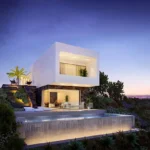
Barn Conversion
Environmental Sustainability Net
zero carbon barn Conversion
Climate change is now one of the leading problems facing everyone. Elevated CO2 emissions entering the atmosphere from domestic and business sectors contribute over 30% of the total CO2e emissions in the UK alone. The barn conversion was designed to be net zero carbon and therefore passive. Using the accredited CREO build and renewable heating and ventilation systems the new building will in effect add zero carbon contributions to the environment over the operating lifetime of the building.
The construction was erected using the BBA approved CREO ICF, (insulated concrete forms) system. This system provides a low u-value of
0.14 W/m2K. The Creo system comprises interlocking hollow insulating blocks, typical size 350 x 250 x 1000 consisting of 2 leaves of insulation with 4 No. Insulating connector pieces, all external walls were sealed, and an air movement system, (Mechanical heat and ventilation), installed to overcome the necessity for trickle ventilation and provide controlled moisture levels and air quality.
The system completely removes any form of thermal cold bridging. Air to water air source heat pumps, solar PV power the building. A rainwater harvesting system additionally provides rainwater, which reduces demand from the public processed water system. Low energy LED lighting systems and cooking appliances will further reduce power demand.








SUBSCRIBE TO OUR NEWSLETTER
Time is running out
For more information please contact us.







